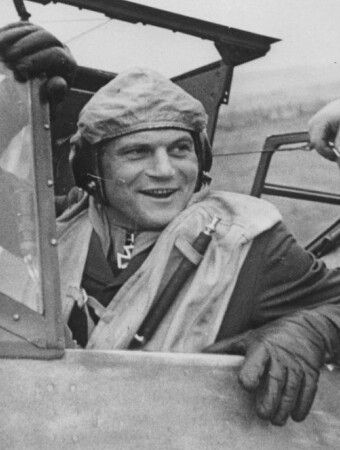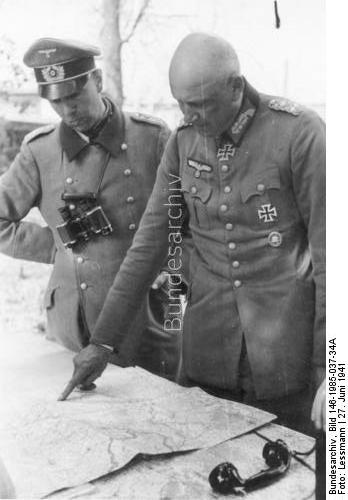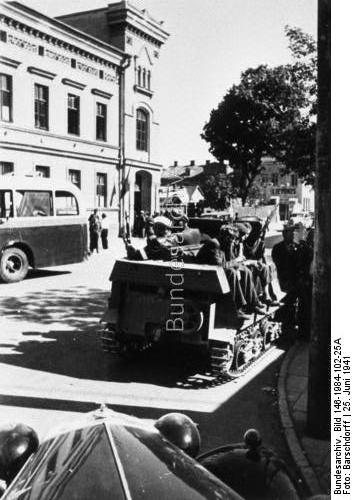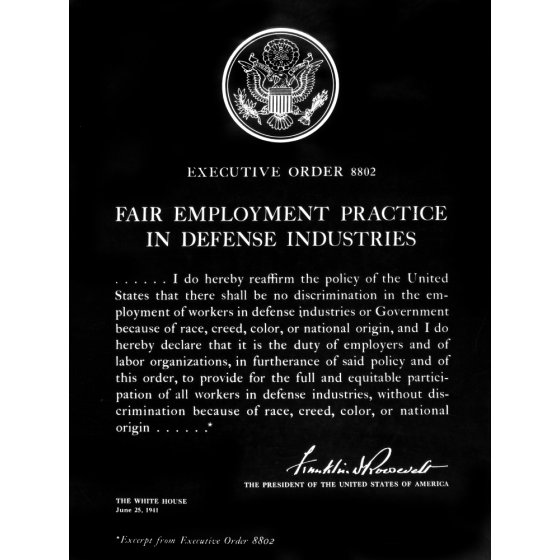Friday 27 June 1941
 |
| Finnish soldiers replace the barrel of a Pz. II. Suomussalmi, Kuivajärvi, Finland - 27 June 1941 (Source: SA-kuva). |
The Finnish sector remains quiet. The Finns are preparing plans for an invasion of the Karelian Isthmus but are not yet ready to attack, while the Soviets are hard-pressed against the Germans and are pulling troops away from the northern sector.
In the Army Group North sector, Adolf Hitler has directed the leading panzer elements of Field Marshal von Leeb's forces to consolidate their positions while the infantry catches up. This includes reinforcing the small bridgehead across the Dvina River secured by German commandos at Daugavpils. German 18th Army advancing along the coast takes the port of Liepaja.
In the Army Group South sector, the German 17th Army continues advancing toward Lviv. Advance elements of the German 11th Panzer Division reach Ostrog, which is 30 km behind Soviet lines. However, the main story is the frantic Soviet effort to stop or blunt the German advance.
A Soviet counterattack against the advancing 1st Panzer Group from both north and south continues at the Battle of Brody. The Soviet 9th, 19th, and 8th Mechanized Corps are involved, but the Soviet attacks are uncoordinated and self-supporting. Some of the Soviet attacks miss the fast-moving panzers and instead hit the following German 6th Army's 297th Infantry Division.
 |
| German column passes a Soviet heavy tank KV-2 which has been destroyed by its own crew, 27 June 1941. This is at the commencement of the 41st Panzer Division move from Kovel (Federal Archive). |
In the Army Group South sector, heavy fighting continues on the right flank of Panzer Group 1. The Russian 8th Tank Corps has effected a deep penetration of our front and is now in the rear of the 11th Panzer Division. This penetration has seriously disrupted our rear areas between Brody and Dubno. The enemy is threatening Dubno from the southwest ... the enemy also has several separate tank groups acting in the rear of Panzer Group 1, which are managing to cover considerable distances.Popel decides to dig in at Dubno and await reinforcements. Other Soviet forces hear of Popel's success and plan their own attacks on the 28th.
However, the Soviet leadership is doubtful that Popel's attack will lead to good things. General Kirponos orders a halt to the counteroffensive, fearing that advancing into the Wehrmacht's flanks will simply make it easier for the panzers to encircle them. In fact, Kirponos is so fearful that, rather than try to exploit Popel's success, he orders a general retreat.
The Luftwaffe continues to have dominance over Soviet skies. However, it is taking losses. One of those today is 34-victory ace Heinz "Pietzsch" Bretnütz, shot down over Lithuania in the opening operations of Operation Barbarossa. Lithuanian farmers hide him from Soviet soldiers for several days, but just after the Wehrmacht arrives, he dies today from a leg injury. Bretnütz was the leader of II./JG 53. While the Luftwaffe has a broad spectrum of pilots who are among the best in the world, it does not have a tremendous amount of depth - so losses of top pilots like Bretnütz matter.
 |
| Heinz "Pietzsch" Bretnütz (24 January 1914 – 27 June 1941). |
Elsewhere, the Vichy French continue to resist fiercely. At Palmyra, site of a major French airbase, the French continue to hold out against the British Habforce lingering in the area.
Royal Navy light cruisers HMS Hotspur, Jervis, Kingston, and Naiad bombard Damour, Lebanon (south of Beirut) at dawn to aid the arduous Australian advance up the coast.
With the sea route to Syria and Lebanon very risky, the Vichy French decide to send a trainload of supplies from France bound for Lebanon.
Free French leader Charles de Gaulle appoints Georges Catroux High Commissioner to the Levant in 1941. He is slated to take over control of Syria and Lebanon once Vichy French General Dentz is removed from power.
European Air Operations: RAF Bomber Command attacks Bremen (108 bombers) and Vegesack (28) during the night.
During the day, RAF Fighter Command sends 23 planes on a Circus mission over Lille. The RAF also conducts two sweeps over the French coast.
 |
| German 45th Infantry Division using a captured T-26B during the fight at the Brest-Litowsk fortress, 25 or 27 June 1941. Near the T-26 is a Somua S-35 from Panzerzug Nr. 28. |
Battle of the Baltic: German motor torpedo boats S.59 and S.60 torpedo and sink Soviet submarine S.10 in the Irben Strait.
The Luftwaffe bombs and sinks Soviet G-5 motor torpedo boats N. 27 and No. 47 off Estonia.
German motor torpedo boats S-43 and S-107 hits a mine and blows up north of Hiiumaa.
Soviet submarine L-3 lays mines off of Memel. Finnish ships also lay mines.
The Soviets scuttle freighter Mariampol at Riga as they prepare to retreat.
The Wehrmacht captures many ships of the Latvian State Shipping Co. at the Port of Liepaja, including:
- MV AUSEKLIS (SU 1700 grt)
- MV VELTA (SU 3100 grt)
- MV VENTA (SU 2830 grt)
- MV KAIA (SU 244 grt)
- MV OGRE (SU 416 grt)
- MV RAUNA (SU 3100 grt)
- MV SPIDOLA (SU 4650 grt)
 |
| Soldiers on both sides are dying in massive numbers on the Eastern Front. Gunner Heinz Sagawe, killed June 27, 1941 |
U-556 (Kptlt. Herbert Wohlfarth), on its second patrol out of Lorient and operating midway between southern Greenland and Iceland, attacks Convoy HX-133 but attracts the attention of convoy escorts. U-556 is sunk by depth charges from the British Flower-class corvettes HMS Nasturtium, Celandine, and Gladiolus. Five of the crew are killed and 41 (including Wohlfarth) survive. U-556 has sunk six ships totaling 29,552 tons and damaged another of 4,986 tons.
U-564 (KrvKpt. Reinhard Suhren), on its first patrol out of Kiel and operating in the mid-Atlantic, also attacks Convoy HX-133. He is a little luckier. The U-boat sinks two ships and damages a third:
8812-ton Dutch tanker Maasdam8651-ton British tanker Malaya IISome sources state that the Kongsgaard was damaged on the 24th, but most agree it was during this attack. In any event, it initially is abandoned by its crew, but they later reboard and Kongsgaard ultimately makes it to Belfast Lough. Incidentally, given that both U-556 and U-564 attack the convoy and only U-564 makes it back, there is always the possibility, however remote, that one of these hits was made by U-556 and not U-564.
9467-ton Norwegian tanker MV Kongsgaard
 |
| Colonel-General Adolf Strauss (with Knight's Cross, right) discussing the situation with a captain over the map, 27 June 1941 (Lessmann, Federal Archive, Bild 146-1985-037-34A). |
Royal Navy destroyer HMS Wishart spots Italian submarine Glauco west of Gibraltar and moves in to attack. After the submarine is damaged, the Glauco's crew scuttles it and goes into captivity. All 51 aboard the submarine survive.
U-69 (Kptlt. Jost Metzler), just ending its third patrol out of Lorient and operating off the west African coast, sights Convoy SL-78. It torpedoes and sinks two ships about 200 nautical miles (370 km; 230 mi) southeast of the Azores:
7603-ton British transport Empire Ability (two deaths, 107 survive)U-69 still has not returned to port since the sinking of US freighter Robin Moor, which caused an international incident. However, having just used its last two torpedoes and low on fuel, U-69 now breaks off the attack and heads back to port at St. Nazaire. However, it notifies U-boat headquarters in Paris of the convoy's location, and Admiral Doenitz vectors in U-66 and U-123 for further attacks.
5423-ton British freighter River Lugar (38 dead, 6 survivors rescued by convoy escorts Burdock and Armeria).
U-123 (Kptlt. Karl-Heinz Moehle), on its fifth patrol out of Lorient, then also attacks Convoy SL-78. It sinks two ships:
5646-ton British ship P.L.M. 22 (32 dead, 12 survive)U-123 then takes the full fury of the Royal Navy escorts' fury at having lost so many ships in one day. In an epic 11-hour depth-charge attack, Moehle has to dive to an unheard-of 654 feet (199 m) to escape destruction.
1996-ton Dutch freighter Oberon (6 dead)
Royal Navy submarine HMS Clyde departs from Gibraltar on Operation Vigorous. This is a patrol near the Canary Islands looking for a German supply ship that has been reported in the area.
The Luftwaffe bombs and sinks 324-ton Royal Navy minesweeping trawler HMT Force off Great Yarmouth.
The Luftwaffe bombs and sinks 6790-ton Dutch freighter Montferland off Great Yarmouth. Everyone survives.
German 8068-ton blockade runner Regensburg (Kpt. Harder) arrives in Bordeaux, France. It successfully has made passage halfway around the world from Dairen (aka Dalian, Port Arthur), China. These blockade runners are vital to the German economy because they bring materials such as rubber that are becoming scarce.
Royal Navy submarine Submarine L-26 grounds on the west coast of Mull, Scotland. She is refloated on the 28th, taken to Ardrossan and then Plymouth for repairs, and is out of service until February 1942.
Danish freighter Knud Villemoes hits a mine and sinks in the North Sea 3 nautical miles (5.6 km) northeast of Steingrun Prik, Heligoland, Schleswig-Holstein, Germany.
Convoy WS-9B (Winston Special) departs from Avonmouth (the convoy doesn't formally start until the 30th) ultimately bound for Suez, Convoy OB-340 departs from Liverpool, Convoy SL-79 departs from Freetown bound for Liverpool.
 |
| "A 3.7-inch anti-aircraft gun in the Western Desert, 27 June 1941." © IWM (E 3870). |
Italian submarine Jantina attacks Australian sloop HMAS Parramatta off Marsa Matruh. The torpedo misses, and Parramatta launches an unsuccessful depth charge attack against the submarine along with destroyer HMS Stuart. However, the Jantina escapes.
Royal Navy aircraft carrier HMS Ark Royal, pursuant to Operation Railway, delivers 21 Hawker Hurricane fighters to Malta (one other is lost). Furious then sails back to Gibraltar.
Royal Navy submarine HMS Osiris makes an unsuccessful attack on a freighter in the Tyrrhenian Sea.
An Axis convoy of four ships with escorts departs from Taranto bound for Tripoli. It has a heavy escort (some at a distance) including two cruisers and seven destroyers.
Over Malta, the RAF continues to have success against the Regia Aeronautica. A formation of Hawker Hurricanes intercepts a large formation of Italian Macchi fighters - considered to be among Italy's best. The British shoot down six of the Italian planes and damage several others. This is Italy's version of RAF Circus operations over France, as the large formation of Macchi's only escort one SM-79 bomber that is there only to entice the Hurricanes into battle.
Battle of the Black Sea: Soviet submarine SC-206 spots a ship and attacks it. Unfortunately for the crew of the SC-206, it is a fellow Soviet ship, Flotilla Leader Kharkov, which is returning from operations off Romania. The Soviet ships escorting the Kharkiv quickly attack and sink SC-206.
Battle of the Pacific: German raider Komet makes a rendezvous with captured whaler Adjutant, which has just completed laying mines off of New Zealand. With its usefulness at an end, Adjutant is scuttled and Komet sails off on its next mission.
 |
| British war casualties notice published on 27 June 1941 in the Times and the Clitheroe Advertiser. |
The Luftwaffe bombs and sinks 288-ton Latvian ferry Vieniba, apparently being used as a hospital ship, near Libava (Libau). The ship sinks close enough to land for eight crewmen to swim to shore, and five other people are rescued later. However, an unknown number of people estimated at around 800 perish in the sinking, including many Latvians. The ship reputedly is carrying a large number of wounded soldiers.
There is a major caveat to the "loss" figures, as some claim that many Estonian crewmen survive the sinking. However, according to these rumors, they decide not to reveal their survival because they do not wish to get killed in the war. So, the figure of 800 dead may be somewhat lower - but not necessarily.
The reason this is a controversial sinking is (with the proviso that these are unreliable sources) the Wehrmacht knows that the Vieniba is a hospital ship and agree not to attack it. However, this information does not get to the Luftwaffe, which sinks it anyway.
Partisans: The Central Committee of the Communist Party of Yugoslavia appoints Joseph Broz "Tito" as Commander-in-Chief of the Yugoslavian Peoples Army. This is one of two competing partisan forces that are in the embryonic phase in Yugoslavia - and they have a very difficult relationship.
 |
| Battleship Iowa under construction New York Navy Yard, New York, United States 27 June 1941. |
Propaganda: In public, the Soviet government pretends that all is well. Today, it announces:
Our troops are fighting fiercely against large Fascist armoured units in the Minsk area. The battle is still going on. Violent armored conflicts have been waged all day near Lutsk [in western Ukraine; in Polish, it means "Luck"]. Our operations have proceeded favorably.In fact, operations are not proceeding favorably at all. These "happy statements" mirror those of previously besieged regimes, particularly the Poles (and Baghdad Bob decades later, but that's another story).
This isn't fooling anyone. According to British correspondent Alexander Werth in "Russia at War 1941 to 1945" (London 1964), savvy Soviet citizens know how to read between the lines and "decode" official statements. When a communique says that there is successful fighting "in the direction or" or "in the area" of such-and-such place, it simply means the fighting has reached that city and it is about to fall. Thus, the official statements are a handy way of keeping track of how far the German invasion has penetrated. They also provide clues as to how much time is left before the readers themselves will have to seek refuge or welcome the invaders.
 |
| "A Bren gunner of the Norwegian Brigade takes aim during training at Dumfries, Scotland, 27 June 1941." © IWM (H 11120). |
German/Soviet Relations: At some point during this week - details are very sketchy - Soviet Premier Joseph Stalin attempts to broker a peace deal with Hitler through a Bulgarian diplomat, Ivan Stamenov. Foreign Minister Molotov has Lavrentiy Beria arrange this by using one of Beria's subordinates, NKVD officer Pavel Sudoplatov, who has a "casual" lunch at a Moscow restaurant with the diplomat. Sudoplatov explains to Stamenov what to say to Hitler. Stalin is willing to offer huge concessions for peace, including Ukraine and all of the areas granted to him in the "secret protocol" to the 23 August 1939 Molotov/Ribbentrop Pact in the Baltic States. Stalin does, though, demand to know why Hitler invaded the USSR.
Hitler turns Stalin down flat and will not even consider the offer. This is one of Hitler's biggest mistakes. These revelations were hidden for many years but came to light during the period after Stalin died from natural causes in the 1950s. There are few other details of this little-known incident, but there is no reason to doubt that it happened. This peace offer was classified as treason and was one of the charges used to condemn Beria to death. The others involved - including the Bulgarian Stamenov diplomat used as the go-between - submitted affidavits confirming the incident. Sudoplatov confessed to it under interrogation and also was convicted of treason, serving 15 full years in prison (yes, there are many questions about the validity of such "proof," but there was a lot of corroboration). Molotov was never tried for treason despite his deep role in the incident, but gradually fell out of favor, lost his positions one by one, and by 1962 was a "non-person" in the Soviet bureaucracy.
Japanese/Dutch Relations: The Japanese conclude negotiations with the government in the Dutch East Indies. They have not gotten what they wanted, which is complete control of all exports.
Soviet Military: The government mobilizes members of the Komsomol - the Soviet equivalent of the Hitler Youth - as "political soldiers."
 |
| Douglas XB-19. |
This first flight goes well, though the four 2,000 hp Wright R-3350 air-cooled radials engines show a tendency to overheat. The real problem is that this flight is over three years since the construction contract was awarded. During that time, the B-17 has gone from the drawing board to airfields in England. Already, the expensive XB-19 bomber is considered past its prime and virtually obsolete, but the US Army Air Force considers it a useful test-bed for future bombers. Douglas is not particularly happy about the contract - it has sunk $4 million of its own money into the bomber's development above and beyond the $1.4 million that it has received from the USAAF.
 |
| Kaunas, Lithuania, Jewish men dragging a German tank under the supervision of German soldiers and local militiamen, 27 June 1941 (Source: Yad Vashem Photo Archive). |
While this situation meets Hitler's needs, his staff privately is grumbling about the environment. General Alfred Jodl's staff diarist writes in a private letter:
We are being plagued by the most awful mosquitoes. It would be hard to pick on a more senseless site than this—deciduous forest with marshy pools, sandy ground, and stagnant lakes, ideal for these loathsome creatures.Having little to do seems to focus Hitler on the minutiae of operations, something that previously he largely left to the generals. He begins coming to the conclusion - as he had at Dunkirk in May 1940 - that the panzers are rushing ahead too fast and need to be restrained, especially in the Army Group North sector.
 |
| The massacre of 68 Jews in the Lietukis garage of Kaunas (Lithuania) on either 25 or 27 of June 1941. |
Without taking anything away from the culpability of the Einsatzgruppen, many of these pogroms are public and entirely in the open, with locals eagerly participating. In fact, often local citizens take up crowbars or other blunt instruments and beat their victims in front of laughing crowds.
American Homefront: New York Yankee Joe DiMaggio gets a home run and another hit in three at-bats against the Philadelphia Athletics. This extends his hitting streak to 39 games.
Metro-Goldwyn-Mayer releases "They Met in Bombay," starring Clark Gable and Rosalind Russell. Gable and Russell play jewel thieves whose plans fall apart when Gable's character inadvertently becomes a war hero.
Future History: Krzysztof Kieślowski is born in Warsaw, Poland. He grows up to become a top European director perhaps best known for "Dekalog" (1989), "The Double Life of Veronique" (1991), and the "Three Colors trilogy" (1993–1994).
June 1941
June 1, 1941: Farhud Pogrom
June 2, 1941: Massacres on Crete
June 3, 1941: Kandanos Massacre
June 4, 1941: Kaiser Wilhelm Passes Away
June 5, 1941: Death in Chungking
June 6, 1941: Hitler's Commissar Order
June 7, 1941: Commandos Strike at Pessac
June 8, 1941: British Invade Syria and Lebanon
June 9, 1941: Litani River Battle
June 10, 1941: British Take Assab
June 11, 1941: Hitler Thinking Beyond Russia
June 12, 1941: St. James Agreement
June 13, 1941: Lützow Damaged
June 14, 1941: Latvian June Deportations
June 15, 1941: Operation Battleaxe
June 16, 1941: The Old Lion
June 17, 1941: British Spanked in North Africa
June 18, 1941: Turkey Turns Its Back
June 19, 1941: Cheerios Introduced
June 20, 1941: Birth of US Army Air Force
June 21, 1941: Damascus Falls
June 22, 1941: Germany Invades Russia
June 23, 1941: A Soviet KV Tank Causes Havoc
June 24, 1941: Kaunas and Vilnius Fall
June 25, 1941: Finland Declares War
June 26, 1941: Bombing of Kassa
June 27, 1941: Encirclement At Minsk
June 28, 1941: Minsk Falls
June 29, 1941: Brest Fortress Falls
June 30, 1941: Mölders Becomes Top Ace
2020


















